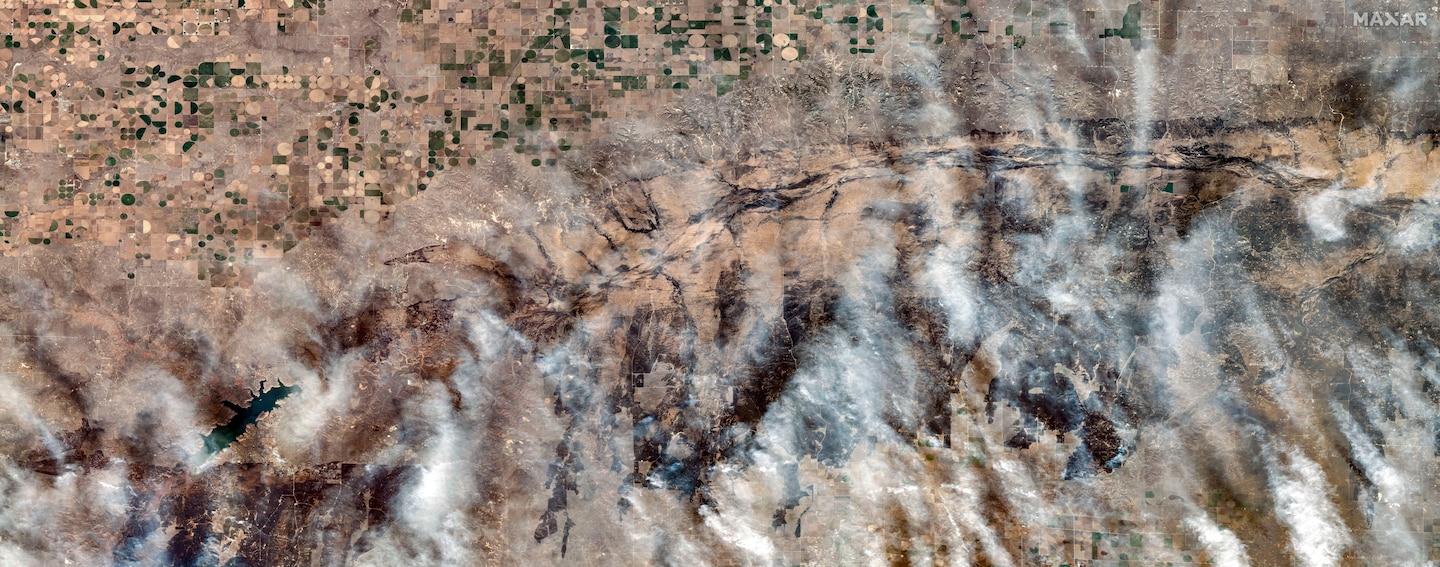Fast-moving flames devastated what is the heart of Lone Star State cattle country, torching about 2,000 square miles of grasslands that feed tens of thousands of cattle. Some 3,600 animals have died, and more will be euthanized because fires burned their hooves and udders, said Sid Miller, Texas’ commissioner of agriculture. It could take years for grasses to regrow and cattle to return, he said, while costs of rebuilding fencing, barns and other ranch infrastructure, estimated to be massive, won’t be covered by insurance.
The disaster comes less than a year after flooding from nearly a year’s worth of rain inundated other parts of the panhandle region. Then, drought conditions parched vegetation across the region. It’s a cycle that is heightening wildfire risks across the West and Southwest, experts say, but that some Texas farmers say is just part of life in the panhandle.
Jared Blankenship, a rancher and farmer in Hereford, Tex., who represents the region for the Texas Farm Bureau Federation, said he remembers his grandfather talking about similar swings in weather and fortunes decades ago. Fires are always a concern in a part of the country where arid conditions are common, even if the flames don’t usually spread so rapidly.
“We just have these aberrant years one way or the other and it seems to be boom or bust, regrettably,” Blankenship said. “We kind of grow accustomed to these events on a regular basis.”
It’s just a part of the world “where it can happen again tomorrow.”
And yet, what was already the largest fire on record in Texas is still expected to grow larger, even as conditions for firefighting improve. The Smokehouse Creek Fire had burned across 1,059,570 acres and was 37 percent contained as of Tuesday morning, according to the Texas A&M Forest Service. (That was slightly smaller than earlier estimates because of improved mapping, the forest service said.)
Miller predicted its footprint could surpass 2 million acres before it’s extinguished, perhaps as soon as this weekend if firefighters continue making progress at containing the blaze. That would make it the third-largest wildfire in U.S. history, ahead of any on record in California and behind only blazes that occurred more than a century ago across less developed landscapes.
Char Miller IV, a professor of environmental analysis at Pomona College, said global warming is now intensifying cycles of weather “whiplash” like the Texas panhandle has experienced, with extreme rainfall fueling plant growth and then extreme heat and drought turning it to kindling. It isn’t just raising fire threats in Texas, the former professor at Trinity College in San Antonio said.
“That’s as true in California as it is in Texas,” Miller said. “It’s as true in Arizona as it is in Colorado.”
In the Texas panhandle, the fire moved across rangeland where grass grows tall and thick, allowing for flames to climb 20 to 30 feet high, Sid Miller said. It destroyed several thousand miles of fence, which costs about $10,000 per mile to put up, he said. And some ranches lost all of their cattle, which each cost about $3,000 to replace. Insurance doesn’t cover their burial, either, he said.
Other weather extremes had already tested farmers in the region. Drought caused recent cotton crops to fail, Sid Miller said. And poorly timed downpours and hail last spring and summer meant there was hardly any tomatoes harvested in the region, and some farmers were limited in how much sweet corn they could plant, said Adrianne Brockett, manager of the Hutchinson County farmer’s market.
“It may take some of them down,” Sid Miller said. “It’s pretty tough to overcome.”
Now, many cattle ranchers are left to figure out how to move forward. Farmers from across the state and region are sharing hay bales so remaining cattle have something to eat, but many of the livestock will have to be relocated elsewhere indefinitely, Blankenship said.
While the panhandle region is home to about 85 percent of Texas’ 11 million head of cattle, Sid Miller said, ranchers’ losses are not expected to have a broader impact on beef supply or prices. Kevin Good, a vice president at industry research firm CattleFax, said they represent a tiny fraction of the total U.S. herd and could lead to minimal, if any, upward pressure on beef prices.
Still, the threat of more fires is expected to linger in the months ahead.
In Texas, prairie fire season can begin as early as November and commonly spikes around March and April, when winds tend to kick up, said Karl Flocke, a woodland ecologist with the Forest Service. For fires to spread as rapidly as they have recently, he said, it just takes strong winds and heavy, continuous grass cover — plus an ignition, usually caused by humans.
For now, relatively calm winds are in the forecast, and some cold rain or light snow is forecast across the panhandle on Friday.
But the strongest winds of the year typically arrive in the weeks ahead — southwesterly gusts of 40 mph are common in March and April, Blankenship said — there is concern not just over more fires, but of wind-driven erosion on areas that have already burned. That will continue until significant rain falls and new grasses can take root.
“There’s nothing holding the ground down,” Blankenship said.
As aid flows into the region to help farmers and ranchers rebuild, Sid Miller said he is also encouraging them to take care of themselves. Like other states, Texas has a dedicated hotline for them — the AgriStress Helpline — staffed by operators trained specifically on the crises of practicing agriculture in such a challenging environment.
